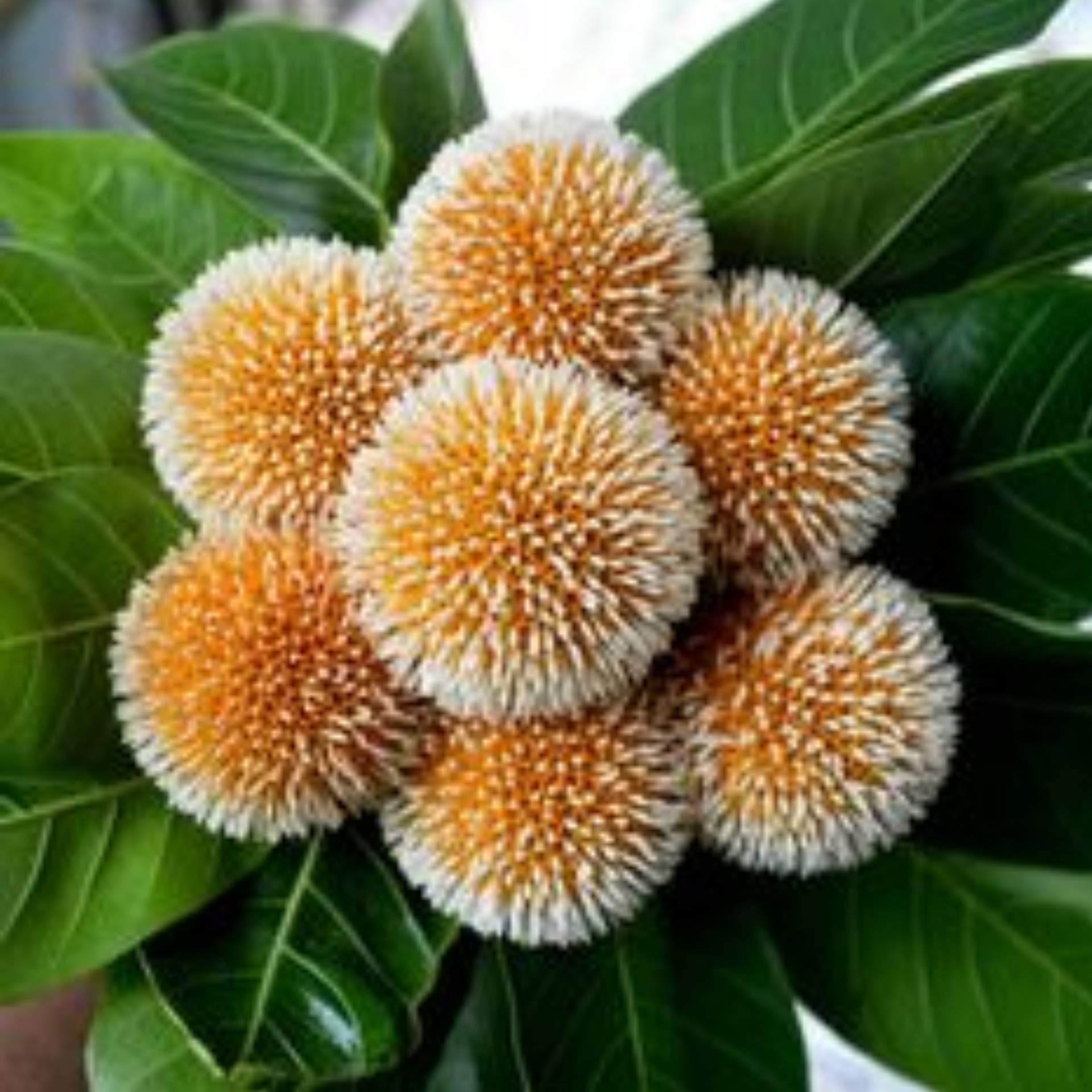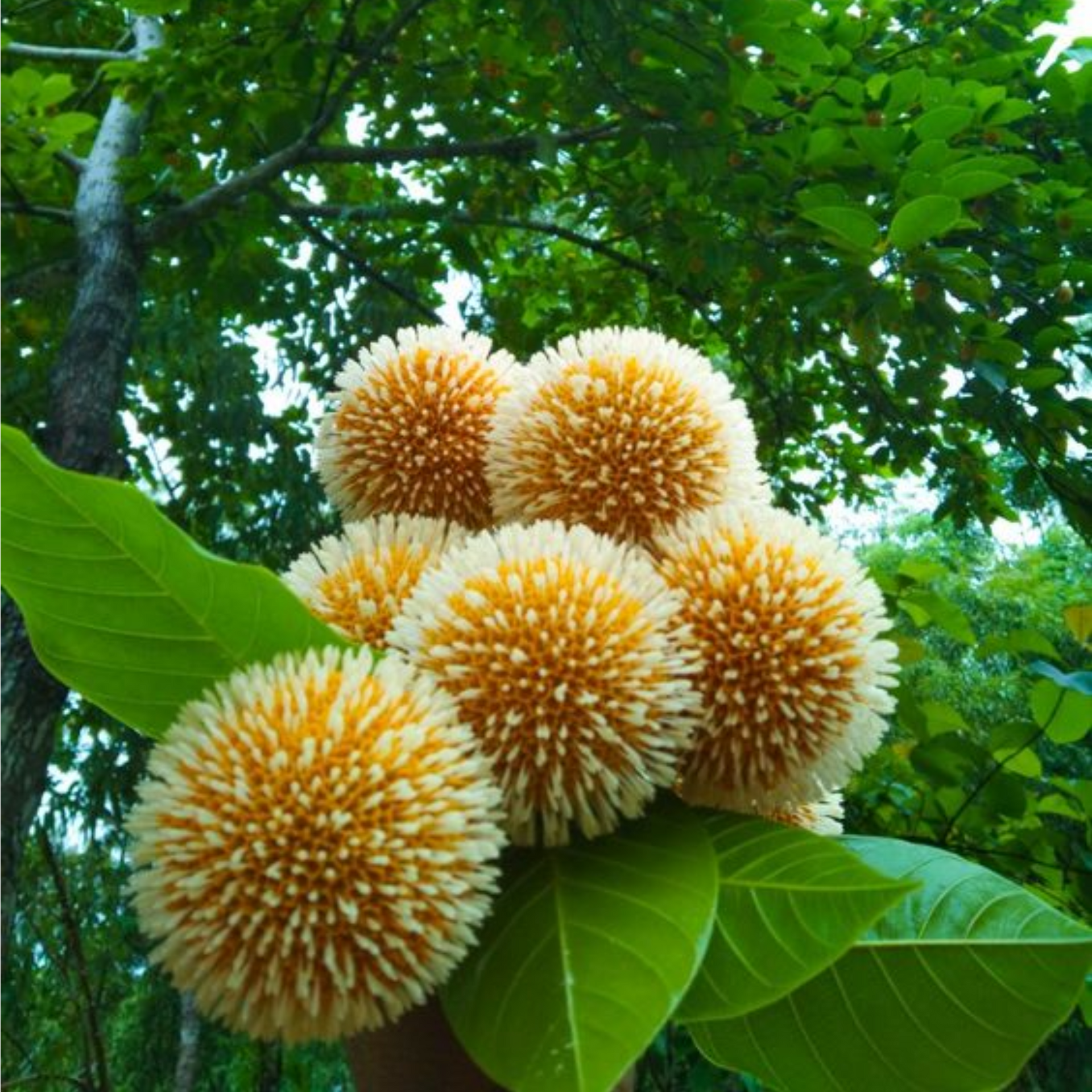



green paradise kadamba Tree krishna kadamb tree live plant
Rs. 499.00
Rs. 399.00
Guaranteed Safe Checkout
The Enigmatic Beauty of the Kadamba
Plant: A Botanical Wonder
The world of plants is a treasure trove of diversity, with each species bearing its unique charm and significance. Among these botanical wonders, the Kadamba plant (Neolamarckia cadamba) stands out as a symbol of beauty, cultural importance, and ecological value. This article delves into the captivating realm of the Kadamba plant, exploring its origins, characteristics, cultural relevance, and ecological contributions.
Origin and Habitat
- The Kadamba plant, scientifically known as Neolamarckia cadamba, is a tropical tree native to South and Southeast Asia.
- This species thrives in a variety of soil types, ranging from clayey to sandy, and is typically found in moist, lowland regions.
- Its natural habitat spans across countries such as India, Bangladesh, Sri Lanka, Myanmar, Indonesia, and Malaysia, where it graces the landscape with its lush foliage and vibrant flowers.
Physical Characteristics
- One cannot help but be captivated by the striking appearance of the Kadamba tree.
- It is a deciduous tree that can reach heights of up to 45 meters (148 feet) and boasts a wide canopy of glossy, dark green leaves.
- The leaves are simple, elliptical, and can measure up to 15 cm in length.
- However, what truly sets the Kadamba tree apart is its stunning, ball-shaped flowers.
- The Kadamba flowers are a sight to behold, resembling golden-orange pom-poms.
- These fragrant blooms appear in dense clusters, making the tree look like it's adorned with golden ornaments.
- The mesmerizing fragrance of the flowers further enhances their allure, attracting a variety of pollinators, including bees and butterflies.
Cultural Significance
- The Kadamba tree has deep-rooted cultural significance in various parts of South Asia.
- In Hindu mythology, it is revered as the favorite tree of Lord Krishna.
- Legend has it that Lord Krishna and Radha, his beloved, spent countless moments beneath the cooling shade of the Kadamba tree.
- This association has elevated the Kadamba tree to a symbol of love and devotion in Hindu culture.
- Furthermore, Kadamba flowers are an essential part of many religious rituals and ceremonies.
- They are often offered to deities in temples, and their sweet fragrance is believed to please the gods.
- The flowers are also used in the preparation of traditional perfumes and garlands for special occasions.
Ecological Importance
- Beyond its cultural significance, the Kadamba plant plays a vital role in maintaining ecological balance.
- Its dense foliage provides a habitat for a wide variety of birds and insects.
- The nectar-rich flowers are a valuable source of food for pollinators, contributing to the pollination of other plants in the ecosystem.
- Additionally, the Kadamba tree's extensive root system helps in preventing soil erosion, making it a valuable asset in regions prone to heavy rainfall and flooding.
- It also helps in improving soil fertility through its leaf litter, which decomposes to enrich the soil with organic matter.
Conservation Efforts
- While the Kadamba plant continues to thrive in its native habitat, its populations are facing threats due to deforestation and habitat destruction.
- Recognizing its cultural and ecological importance, efforts are being made to conserve and propagate this species.
- Botanical gardens and conservation organizations are working to cultivate Kadamba trees, both for their cultural value and their ecological contributions.
- These initiatives aim to ensure that future generations can continue to appreciate the beauty and significance of this remarkable plant.
Unveiling the Secrets of Growing the Enchanting
Kadamba Plant
The Kadamba plant, with its delicate, aromatic blossoms and rich mythological significance, has been cherished in Indian culture for centuries. If you're eager to bring this exotic beauty into your garden or home, this article will guide you through the process of nurturing and caring for the Kadamba plant.
The Kadamba Plant
- Scientifically known as Neolamarckia cadamba, the Kadamba plant is a tropical tree native to the Indian subcontinent and Southeast Asia.
- It's renowned for its striking yellow and orange blossoms, which exude a sweet, intoxicating fragrance.
- These blooms hold a special place in Hindu mythology, often associated with Lord Krishna and his divine play, making the plant even more revered in Indian culture.
Selecting the Perfect Location
- The first step in growing a healthy Kadamba plant is selecting an ideal location.
- Kadambas thrive in full sunlight, so choose a spot in your garden or on your property that receives at least 6-8 hours of direct sunlight each day.
- Ensure the soil in this area is well-draining, as Kadambas don't tolerate waterlogged roots.
Preparing the Soil
- Kadamba plants prefer slightly acidic to neutral soil with good organic content.
- You can prepare the soil by mixing compost or well-rotted manure into the planting hole.
- This enhances soil fertility and drainage.
- The plant is relatively adaptable when it comes to soil type, but well-draining, loamy soil is optimal.
Planting Your Kadamba
- Now, it's time to plant your Kadamba sapling.
- Ensure that the planting hole is deep and wide enough to accommodate the root ball comfortably.
- Place the sapling in the hole, making sure it's at the same depth as it was in its nursery container.
- Fill the hole with soil and thoroughly water it to settle the soil around the roots.
Watering and Moisture
- While Kadamba trees are relatively drought-tolerant once established, they do require consistent moisture during their initial growth phase.
- Water your Kadamba regularly, especially during dry spells.
- Once the tree matures, it can withstand short periods of drought, but it's always a good practice to keep the soil consistently moist.
Pruning and Shaping
- Pruning is an essential aspect of Kadamba plant care. It not only helps maintain a desired shape but also encourages healthy growth.
- Prune your Kadamba tree during the late winter or early spring before the new growth season begins.
- Remove dead or diseased branches and any overcrowded growth to improve air circulation within the canopy.
Fertilizing Your Kadamba
- Kadambas are moderate feeders and benefit from regular fertilization.
- Use a balanced, slow-release fertilizer during the growing season (spring to early autumn).
- Overfertilizing can result in excessive leaf growth at the expense of blossoms.
Pest and Disease Management
- Kadamba plants are generally hardy but can be susceptible to aphids, mealybugs, and scale insects.
- Regularly inspect your tree for signs of infestation and treat with appropriate insecticidal soap or neem oil if necessary.
- Proper pruning and good air circulation can also help prevent disease issues.
Enjoying the Kadamba's Beauty
- Once your Kadamba plant matures, typically within a few years, it will reward you with its stunning, fragrant blossoms.
- These blooms are not only a treat for the senses but also a reminder of the rich cultural heritage associated with this magnificent tree.
- Take time to relish the beauty and fragrance of your Kadamba, and perhaps, like so many before you, find a sense of connection with the ancient myths and legends that surround it.
- In conclusion, growing a Kadamba plant can be a deeply rewarding experience.
- With the right care and attention, you can cultivate a living symbol of tradition and beauty in your own backyard or garden, and continue the legacy of this remarkable tree.




